If the weather were on our side, we were looking to do a big semi-circuit anti-clockwise tramp. From Ballard Hut to Kiwi Mouth Hut via Venison Top and Manson, around to Mackintosh Spur via Kiwi Saddle, down Mackintosh, across Matauria Ridge returning to the Makahu Saddle carpark. But we (party of two) learnt ahead of the trip, it could be tough going on Mackintosh Spur and along the Matauria Ridge due to significant tree damage from the recent snowfalls. This meant we may need to return to the carpark via the main range and down Makahu Spur. Mackintosh might need to be another trip.
The Tops
At Ballard Hut (1400m), we woke to a perfect morning – clear blue sky and no hint of wind. It seemed too good to pass up traversing the main range with such good weather. We decided to go clockwise and head to the tops to take advantage of the near perfect conditions. We knew however, such a change of plan could blow sections of our planned route out of the water. It would likely come down to what the weather would do mid-week. Fortunately we were able to change our plans any way we wished, providing we return to Makahu Saddle carpark on Kaweka Road, where our car was parked.
The climb up to the ridge from Ballard Hut had us reach the large cairn in 25 minutes (0.5km and 180m ascent). (If coming to Ballard Hut from the tops, take care in poor visibility. Two other small spurs in close proximity come down from the cairn. It’s the middle spur, poled with waratahs that will take you to the hut.)

We head east to Whetu (1650m). The next prominent peaks are North Kaweka (1707m) and then Kaweka J (1724m) with less prominent high points overlooking spectacular catchments. If there are strong winds, or if it’s a bit icy underfoot, there’s only one potentially ‘scary’ bit in getting up to the main range. It’s a narrow saddle at 1600m just before the last climb up to North Kaweka. But it’s short in length.
The poled route sidles around North Kaweka high point. We take a break, drop the packs and climb up to the peak. (There’s also a trig on a knoll a short rocky scramble beyond the peak). Being a clear day, the views are expansive – the central plateau, the Kaimanawa’s, Hawkes Bay, and 360 degree views of the stunning Kawekas. Coming down from North Kaweka and alongside three snow covered tarns, we see Dominie Hut on Makahu Spur. With clear visibility, the bright orange paintwork is easy to spot.
The stark difference between the Kaweka and Tararua tops is that the Kaweka tops are wide and flat. Underfoot is shingle scree with patches of vegetation – mostly tussock and small alpine plants. Around 3.5 hrs after leaving Ballard Hut (7.5km) we reach Kaweka J. We lunch among the dry tussock in between large but diminishing patches of snow.
The lightly undulating walk along the main range is easy, but then again it is a perfect day. In a howling gale it will be unpleasant as it couldn’t be more exposed. Between North Kaweka and Kaweka J, there are a couple of options to drop off the tops in bad weather. Two tracks to the west will take you to Back Ridge Hut. Alternatively, Makahu Spur to the east will lead you to a night in Dominie Hut. All turn offs are marked with steel signposts and waratahs heading off where you need to head. There’s also a turnoff 30-40 minutes further south along the range that will take you to Studholme Saddle Hut.
Maps can be wrong
From Kaweka J we continue along the main range to Mad Dog Hill. We come across the turnoff that gives us the option to head further on to Studholme Saddle or drop down to Studholme Saddle Hut. We opt for the latter. Half way down the poled route to Studholme Saddle Hut, my partner points out where the hut will be – in a bushy gully to our right. (He recalls the detail from his last visit to the hut some 25+ years earlier). As an avid map reader, I tell him he must be wrong.
According to the map, from the poled route we’re following, we will drop down into the bushy gully on our left, not our right. I direct his attention to a second bush-clad gully. His instinct indicates the map is wrong. Out comes the GPS for a third opinion. Sure enough, the GPS shows we are not on the spur from Mad Dog Hill that I think we are on, as shown as a poled route on the map. Instead, our poled route is on a smaller nondescript spur that comes off below Mad Dog Hill. The poled route we are on is not shown on Map BJ37.
Our pace over the last 200 metres down to Studholme Saddle Hut slows. It’s steep but manageable. We hit the bush line and find damage from the recent snow. As the orange markers are difficult to find, we zero in on the bright orange hut below us. We negotiate fallen trees, snapped off branches and patches of snow on what looks like a track underneath. The vegetation by the creek is especially damaged and the tussock around the hut has been flattened by the snow.
Studholme Saddle Hut (1328m) has four bunks, a fireplace and a not unpleasant long drop. While the hut book indicates no one has stayed there since late June, it’s clear from the smell of residual fireplace smoke that some keen soul had stayed very recently. Like Ballard Hut, the hut has been nicely lined with plywood. The hut’s water source is natural – the creek. It took us five hours (with breaks) to get from Ballard to Studholme Saddle Hut (c. 10.3kms).
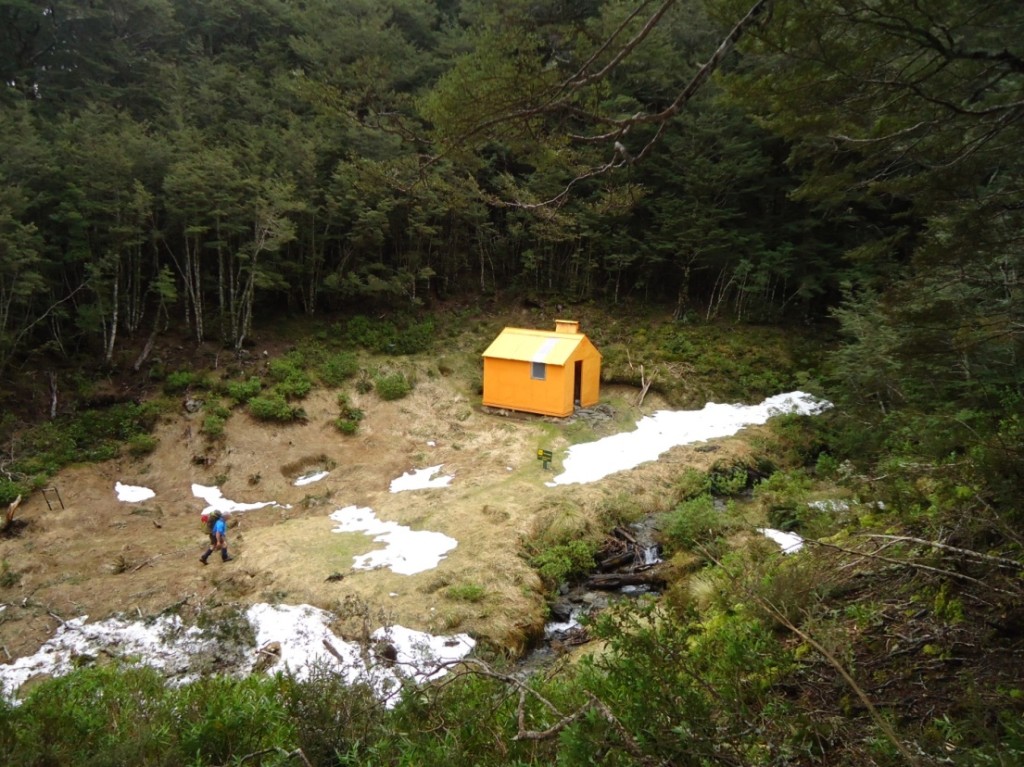
With plans to go on to Kiwi Saddle Hut, we head down the creek to Studholme Biv. Despite further treefall and some snowy patches, it’s an easy twenty-minute walk with a few creek crossings. We find the biv clean and dry; in fact it is one of the better ‘dog boxes’ we’ve come across.
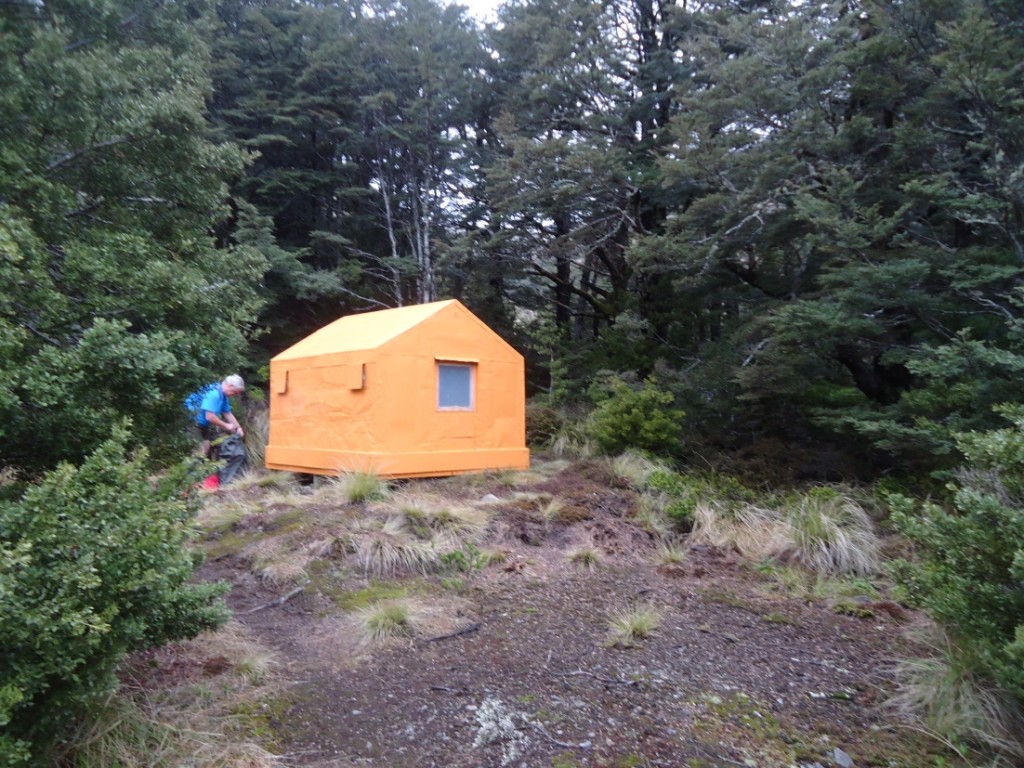
From the biv, a poled route takes us up to the saddle. For the first 100 metres it’s steep with patches of open scree. Within 25 minutes we’re up on Studholme ridgeline. The weather today is not like yesterday. We’ve donned the rain coats. The wind is strong and we know, having cellphone reception, the forecast is bad. Strong gales and heavy rainfall is forecasted for the ranges and the upper half of the North Island.
This is the point when our original plan to get over to the SW section of the Kaweka’s goes awry. We give ourselves two options. One is to continue as planned to Kiwi Saddle and then up Back Ridge and Venison Top, or more directly to Kaweka J, onto Makahu Spur. Either way, we’ll be on the tops when the bad weather hits. The other option is to ‘bush-bash’ our way down the Mackintosh Spur track and out to Makahu Saddle carpark via Matauria Ridge. While the latter is favourable, given we’ll be off the tops, there is no guarantee we can get through to the carpark via Mackintosh because of the storm damage. We are however keen to check out the Mackintosh area. Up for a challenge, we decide to take the Mackintosh option. We accept however that we may need to come back up to the tops to get out via Makahu Spur if we find the Mackintosh tracks impassable.
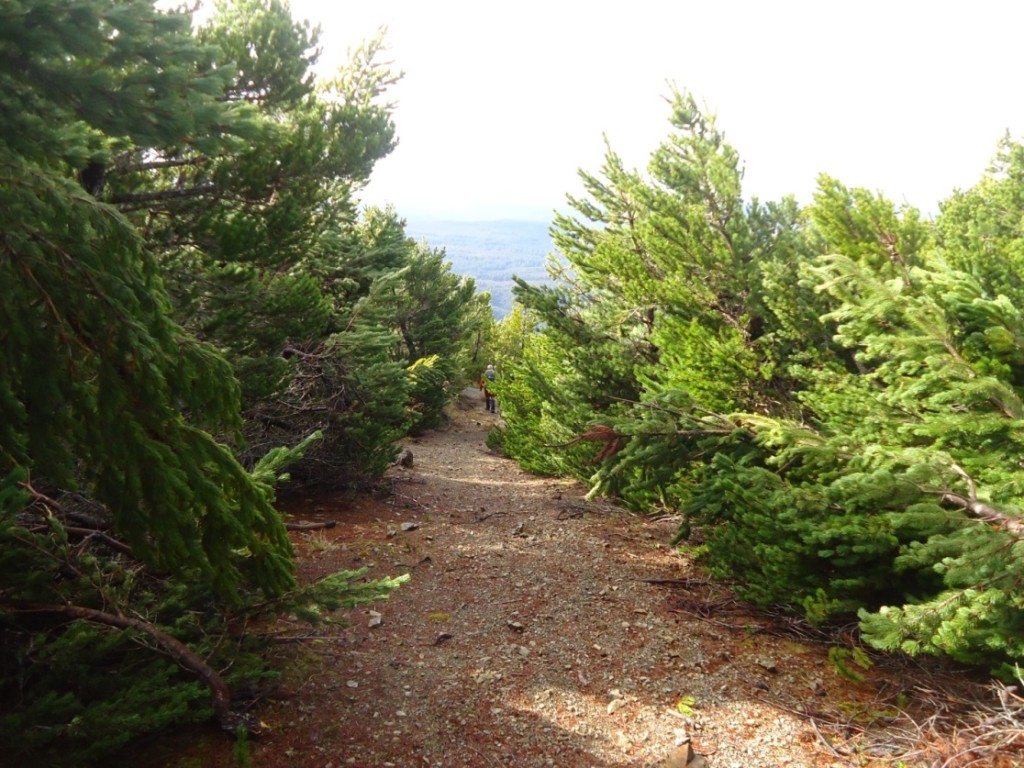

Bush-bashing on marked tracks
At an elevation of 1410m, we start down Mackintosh Spur forty-five minutes after leaving Studholme Saddle Hut. The track starts out wide and clear but neither attributes last as the tree damage becomes evident as we get into thicker bush. We come across a particularly bad tree jam to the point where we lose the track at around 1,030m. Keeping close to the same elevation, we go back and forth a few times trying to relocate the track. It’s hard work as the trees have little give. As neither the map nor GPS help our situation, we rely on a combination of experience and instinct (my partner’s not mine) that the track is to our right. We eventually find it and continue on, wondering how long it will be until the next big obstacle.

For the remainder of the spur, we come across sporadic pockets of tree damage. Numerous trees completely block the track. Many are simply too large to consider anything other than bush-bashing around them, keeping veering too far from where we think the track is, to a minimum. Storm damage aside, the Mackintosh Spur offers a good route off the tops. The out-of-control Pinus contorta provides excellent shelter from the wind just metres from the ridge.
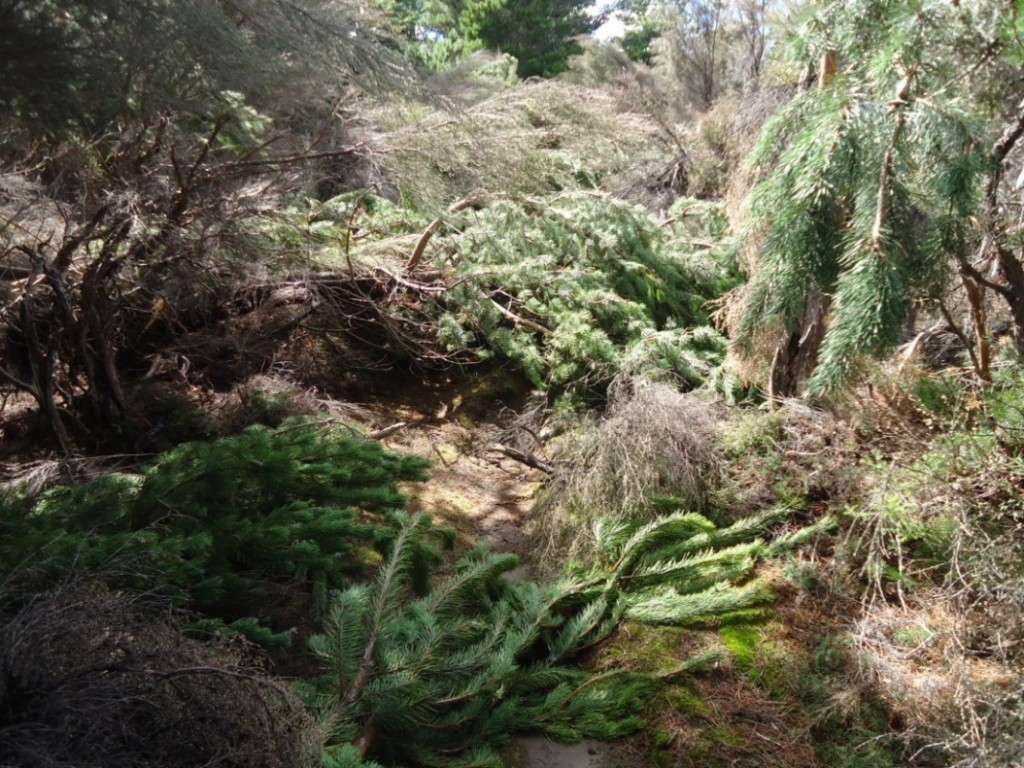
We come across fresh track clearing a few hundred metres from Mackintosh Hut. We understand it’s someone doing it off their own bat since contractors are not due in to clear the damage until later in the month. In just under 6kms from Studholme Saddle Hut, we reach Mackintosh Hut (865m) in 3 hours 20 minutes.
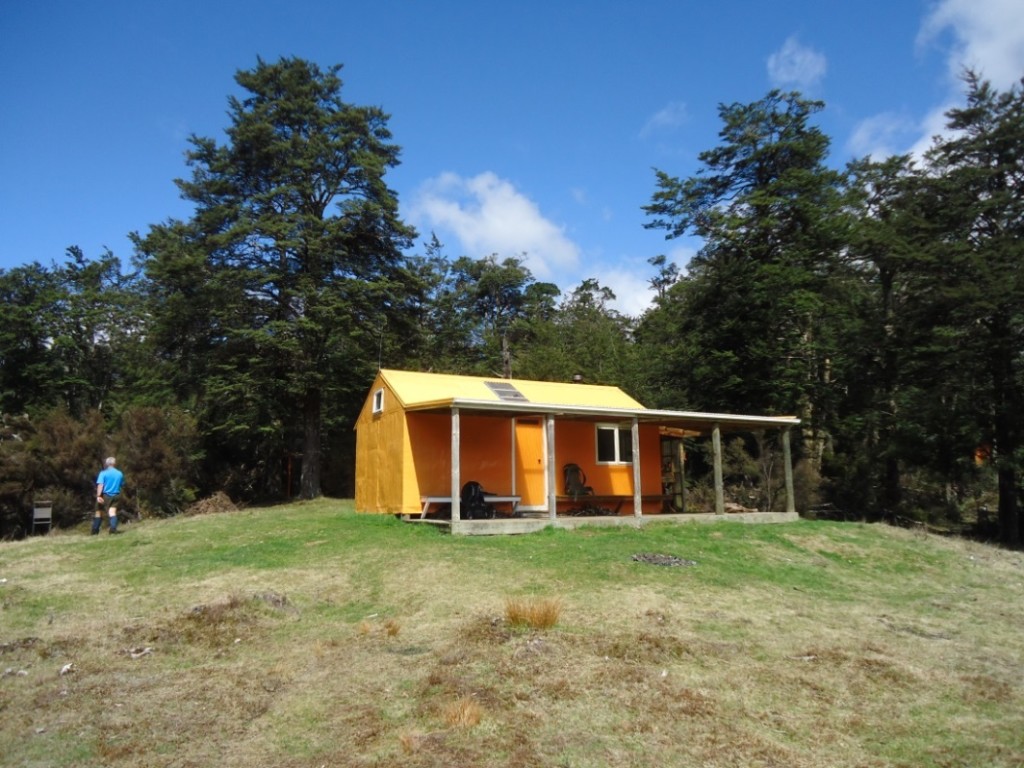
Compared to the Mackintosh Spur, we find the track across the plateau to the top of the Donald River gully pretty good. It’s easier getting through the fallen natives than it is through or over pine trees. The track down the gully to the river (a descent of 260m) is not so easy. We find the track not well-defined and it’s loose underfoot. As we descend, we see fewer and fewer orange markers. We rely on what looks to be a narrow zig-zag track.
As we get closer to the river, the drop down to the water gets steeper. We will want the track on our side to line up with the start of the track on the other side. The river, while not wide, does have swift channels – swift enough to make us pause and consider the safer points for crossing. We’re thankful to the person who tied the pink ribbon on the other side. There’s an otherwise noticeable absence of an orange marker identifying where the track starts on the other side.
Donald River Crossing and Matauria Ridge Exit
We prefer to not head back up to the tops and then down Makahu Spur. Also, knowing the water level will only be higher the following day with the forecasted rain, we decide where to attempt a crossing. My partner gets across first (without falling in) and confirms the current is strong. Not wanting to be left on the Mackintosh side of Donald River, I don’t hesitate in making that first step. The bottom has got large smooth rocks and the current is too strong to walk through normally. Each step is deliberate. A broken tree branch I use like a pole helps keep me on my feet until I’m close enough for my partner to grab my hand. We are now both on the side we want to be. I catch my breath, let the heart rate drop and fill the water bottle. We then start the ascent up out of Donald River, pleased to see it behind us.
The Matauria side of the gully is steeper than the Mackintosh side but it’s not difficult to get up. It has a few rocky spots and more low-growing vegetation. We reach what feels like the top of the gully at 930m. The views back to Mackintosh plateau and up to the tops are worth the climb. It’s been a slow trip to this point though – 2+ hrs (3 kms) since the hut but Matauria Ridge is all we have left (another 4+ kms).
The volume of tree damage on Matauria Ridge is as bad as what we encountered on Mackintosh Spur. However, the trees are smaller which allows us to climb over or crawl under. The ridge track is predominantly clay and more open. Without the tree damage, it would be an easy walk out to the carpark. We get back to the carpark 4 hrs 20 mins after leaving Mackintosh Hut (7.4kms).
While we didn’t get to visit as many huts as we had hoped, we covered plenty of ground. All of it new ground for me. Before leaving Hawkes Bay and for our next visit, we check out the road ends that access the Kaweka’s from the Napier-Taihape Road.
